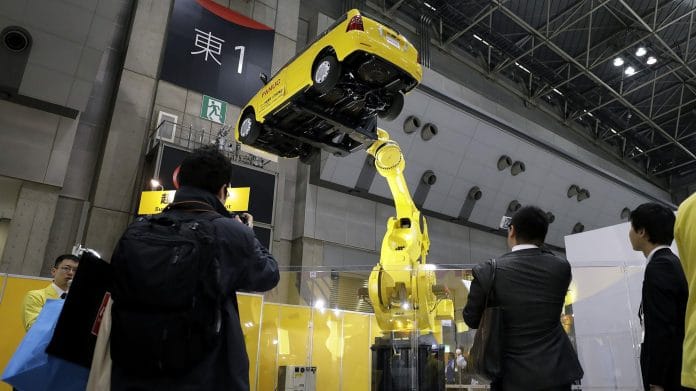For signs of how China’s ambitions to become a self-made, high-tech industrial powerhouse are faring, look to Japan Inc.
The shipment values of Japan’s machinery sector are set to hit record highs, according to Goldman Sachs Group Inc. analysts. Orders placed by Chinese companies for Japanese machine tools have been rising since June and have picked up pace; same for the sector’s general segment. Sales of factory automation equipment are expected to exceed previous peaks.
That’s a reversal from the last two years of Chinese rivals grabbing market share as Beijing doubled down on a drive to increase high-end manufacturing, moving away from the mass market, low-margin goods churned out for the last few decades. Chinese makers of all types of machinery and equipment were nudging out typically upper-end Japanese firms, which warned of waning demand from China and uncertainty around it. Meanwhile, the government’s fiscal stimulus helped buoy sentiment for construction-related machinery like hydraulic excavators, where Japanese companies had a firm footing.
Not all the pressure came from competitiveness; domestic firms barely stand up against the foreign ones. In 2018, the Ministry of Commerce opened a one-year anti-dumping investigation into Japanese and Taiwanese exporters of vertical-machine centers – key equipment manufacturing facilities for cars and other more sophisticated processes. At the time, as I noted, it was a case of playing spoilsport: The numbers didn’t warrant the probe, nor did the impact on prices. Machinery orders had already been slowing, as had shipments for bearings, a proxy for the industry. Citing the complexity, the government extended the case in 2019. By April 2020, it was determined that everything had been fair after all and no duties would be imposed.
The change of tack amid the Covid-19 lockdown and subsequent recovery showed the limits of ambitious industrial policy. China has spent much of the last year focusing on policies to become self-sufficient, scarred by the U.S.-induced rebuke over its practices in global trade and rocky rebound out of the pandemic. A key part of Beijing’s economic blueprint for the next five years is to bolster high-end manufacturing of machines, 5G equipment and semiconductors for use in the domestic market. State funding is increasingly being targeted toward these industries. The government also wants to upgrade internal supply chains and maintain its role as the world’s factory floor. China is by far the largest end-user of industrial robots, but the number of robots installed per 10,000 employees remains relatively low.
In some sectors like 5G, China has doubtless made significant progress. However, the country will continue to rely on Japanese companies for the high-tech niche of manufacturing for a while to come. Consider this: Chinese suppliers command more than 80% of the market share for simple-task linear and Cartesian robots used in the plastics industry. But when it comes to articulated robots, which have more complex multi-axis movements, foreign makers manufacture droves more in and for China, according to CLSA Ltd. analysts. Such machines accounted for over 60% of sales. Japan is one of the largest exporters of industrial robots.
The fact remains that there’s a significant technology gap. More than 75% of reducers, a kind of gear, are imported from Japanese companies like Nabtesco Corp. and Harmonic Drive Systems Inc., according to analysts from HSBC Holdings Plc. These components account for over a third of the cost of industrial robots made in China, compared to 12% for one from Japan. That makes it difficult to be cost-competitive. Chinese companies will have to rely on acquisitions to catch up.
For Japan’s machinery giants, that means the trend – and demand – are here to stay. Chinese volumes will drive business and valuations for manufacturers across the sector. Fanuc Corp., whose yellow robots pepper factory floors making products for companies like Apple Inc., reported that sales in China rose 29% in the first nine months of 2020. Despite a seemingly deep Covid-19 slump in Japan’s economy, the Tankan business survey shows that conditions for manufacturers are increasingly upbeat. The TOPIX Machinery sub-index is up 30% since June; the broader stock market has risen only 17%. Companies are likely to invest more in China to leverage the focus on that country’s inward turn.
China’s ascent as an industrial technology champion won’t happen tomorrow. Barring the risk of shocks from worsening Covid-19-related lockdowns, though, Japan won’t be losing its long-established preeminence anytime soon. – Bloomberg
Also read: Japan considers fines for bars, restaurants to make sure they close early during pandemic






